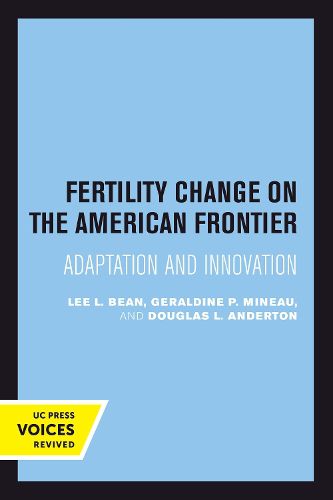Readings Newsletter
Become a Readings Member to make your shopping experience even easier.
Sign in or sign up for free!
You’re not far away from qualifying for FREE standard shipping within Australia
You’ve qualified for FREE standard shipping within Australia
The cart is loading…






With findings that challenge conventional wisdom, Fertility Change on the American Frontier will interest demographers, sociologists, and historians. Examining the marriage and childbearing behavior of one predominantly L.D.S. (Mormon) population, the book calls into question traditional concepts and methods used to study high fertility populations. Mormons were responsible for the settlement, colonization, and development of one of America’s last western frontiers. Availability of detailed information on marriage and childbearing, in a large file of approximately 185,000 family records, makes it possible to study the processes of the decline in fertility more extensively than has ever been done before in a major historical demographic study. The authors examine family formation among cohorts of women born between 1800 and 1899 and contrast two competing explanations of fertility change among Western societies: an adaptation argument versus an innovation argument. They demonstrate that the process of increasing fertility limitation beginning in the later part of the nineteenth century involves more than simply stopping childbearing after a given family size has been achieved. It reflects the adoption of a pattern of child spacing indicating a commitment to family limitation early in the marriage cycle. Clearly we must reexamine earlier studies which assumed that high-fertility populations were not interested in or aware of the possibilities of fertility control. Fertility control can no longer be treated as an innovation of Western industrial societies or as an innovation introduced through national family planning programs. We see that among the Utah frontier population marriage and childbearing represented a rational adaptation to a set of rapidly changing social and economic conditions. Without adequate technologies for family limitation, this population was nevertheless successful in reducing family size quickly and dramatically, once the presumed opportunities of the frontier disappeared. This title is part of UC Press’s Voices Revived program, which commemorates University of California Press’s mission to seek out and cultivate the brightest minds and give them voice, reach, and impact. Drawing on a backlist dating to 1893, Voices Revived makes high-quality, peer-reviewed scholarship accessible once again using print-on-demand technology. This title was originally published in 1990.
$9.00 standard shipping within Australia
FREE standard shipping within Australia for orders over $100.00
Express & International shipping calculated at checkout
With findings that challenge conventional wisdom, Fertility Change on the American Frontier will interest demographers, sociologists, and historians. Examining the marriage and childbearing behavior of one predominantly L.D.S. (Mormon) population, the book calls into question traditional concepts and methods used to study high fertility populations. Mormons were responsible for the settlement, colonization, and development of one of America’s last western frontiers. Availability of detailed information on marriage and childbearing, in a large file of approximately 185,000 family records, makes it possible to study the processes of the decline in fertility more extensively than has ever been done before in a major historical demographic study. The authors examine family formation among cohorts of women born between 1800 and 1899 and contrast two competing explanations of fertility change among Western societies: an adaptation argument versus an innovation argument. They demonstrate that the process of increasing fertility limitation beginning in the later part of the nineteenth century involves more than simply stopping childbearing after a given family size has been achieved. It reflects the adoption of a pattern of child spacing indicating a commitment to family limitation early in the marriage cycle. Clearly we must reexamine earlier studies which assumed that high-fertility populations were not interested in or aware of the possibilities of fertility control. Fertility control can no longer be treated as an innovation of Western industrial societies or as an innovation introduced through national family planning programs. We see that among the Utah frontier population marriage and childbearing represented a rational adaptation to a set of rapidly changing social and economic conditions. Without adequate technologies for family limitation, this population was nevertheless successful in reducing family size quickly and dramatically, once the presumed opportunities of the frontier disappeared. This title is part of UC Press’s Voices Revived program, which commemorates University of California Press’s mission to seek out and cultivate the brightest minds and give them voice, reach, and impact. Drawing on a backlist dating to 1893, Voices Revived makes high-quality, peer-reviewed scholarship accessible once again using print-on-demand technology. This title was originally published in 1990.